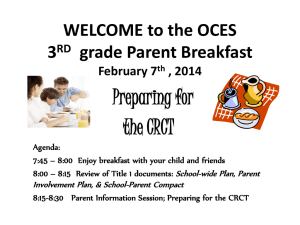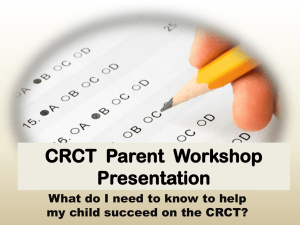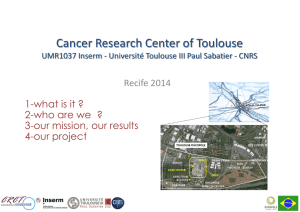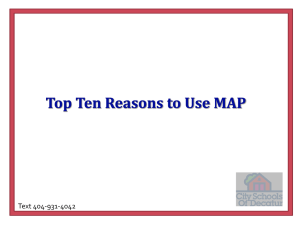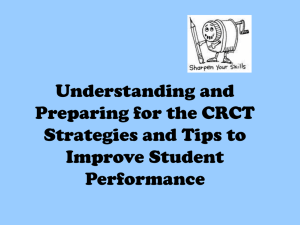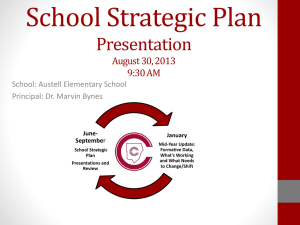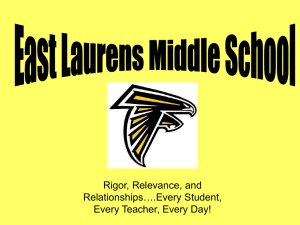CRCT Earth Science Review 6
advertisement
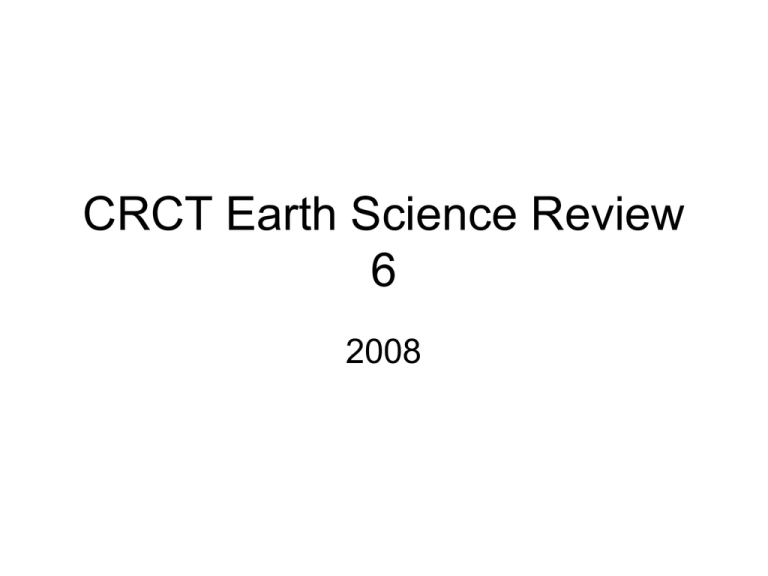
CRCT Earth Science Review 6 2008 Chapter 7 CRCT Preparation 1. How do mid-ocean ridges support both the idea of continental drift and the theory of plate tectonics? A Oceanic lithosphere is destroyed at mid-ocean ridges. B New crust forms at mid-ocean ridges. C Tectonic plates collide at mid-ocean ridges. D The crust at mid-ocean ridges is old oceanic lithosphere. Chapter 7 CRCT Preparation 2. Which of the following compositional layers makes up the greatest percentage of Earth’s mass? A continental crust B oceanic crust C the mantle D the core Chapter 7 CRCT Preparation 3. How does fossil evidence support Wegener’s hypothesis of continental drift? A Similar fossils found on far apart landmasses suggest that the continents were once a single landmass. B Fossil evidence suggests that the continents have always been in their current positions. C No similarities exist between fossils on different continents. D Plant and animal fossils show evidence of changes in Earth’s polarity. Chapter 7 CRCT Preparation 4. Most of the world’s folded mountains formed as a result of A oceanic-oceanic separation at mid-ocean ridges. B continental-continental separation at rift zones. C continental-oceanic collision at subduction zones. D continental-continental collision at convergent boundaries. Chapter 7 CRCT Preparation 5. Which of the following geologic features forms as a result of tension? A an anticline B a syncline C a normal fault D a reverse fault Chapter 7 CRCT Preparation 6. Scientists think that all of the present-day continents were once joined in a single supercontinent called A Pangaea. B Panthalassa. C Laurasia. D Gondwana. Chapter 7 CRCT Preparation Use the diagram to answer question 7. 7. Which of the following structures is shown in the diagram if the bottom layer is the oldest? A a monocline C an anticline B a fault D a syncline Chapter 7 CRCT Preparation 8. The sinking of Earth’s crust to lower elevations is called A rebound. B subsidence. C uplift. D deformation. Chapter 7 CRCT Preparation 9. Sea-floor spreading occurs at which of the following types of tectonic plate boundaries? A transform B convergent C divergent D strike-slip Chapter 7 CRCT Preparation Use the table to answer question 10. 10. According to the table, which of the following statements is true? A Oceanic crust is Earth’s thinnest and least dense compositional layer. B Continental crust is Earth’s thinnest and densest compositional layer. C The mantle is Earth’s thickest and densest compositional layer. D The core is Earth’s thickest and densest compositional layer. Chapter 7 CRCT Preparation 11. The Appalachian Mountains and the Himalaya Mountains were both formed by folding. The Himalayas are still growing taller. The Appalachian Mountains are losing height and becoming more rounded. Why are these mountains changing in different ways? Chapter 7 CRCT Preparation 12. The Cartersville fault formed when metamorphic rocks from Georgia’s Piedmont region were pushed over sedimentary rock layers in the Valley and Ridge region to the west. What kind of fault is the Cartersville fault? Explain your answer. Chapter 8 CRCT Preparation 13. What happens when two tectonic plates push against each other? A Potential energy is released. B Kinetic energy is released. C Potential energy builds up. D Nothing happens. Chapter 8 CRCT Preparation 14. A seismologist is setting up an earthquake research laboratory. Which of the following pieces of laboratory equipment would be the most useful for measuring the magnitude of an earthquake? A Richter scale B seismograph C shake table D epicenterometer Chapter 8 CRCT Preparation 15. An earthquake model that uses gelatin to simulate rock is limited because A rock does not shake during earthquakes. B gelatin has a different density than rock has. C you cannot eat rock. D gelatin has a different color than rock has. Chapter 8 CRCT Preparation 16. Earthquake waves that cause the ground to move up and down, much like ocean waves move water particles, are known as A S waves. B body waves. C surface waves. D P waves. Chapter 8 CRCT Preparation 17. The seismogram shows the ground movement that occurred during a recent earthquake in northwestern Georgia. Which wave type caused the largest ground movements? A P waves C body waves B S waves D surface waves Chapter 8 CRCT Preparation 18. As part of an earthquake modeling lab experiment, Dale must determine the density of a sample of rock. Density is determined by dividing the mass of the sample by its volume. Which pieces of laboratory equipment would be the best choice for making the necessary measurements? A beaker, graduated cylinder B petri dish, balance C balance, graduated cylinder D graduated cylinder, stopwatch Chapter 8 CRCT Preparation 19. What is the difference between plastic deformation and elastic deformation? A In plastic deformation, tectonic plates move on top of a layer of plastic rock; in elastic deformation, they remain fixed. B In plastic deformation, blocks move over one another; in elastic deformation, blocks slide past one another. C In plastic deformation, earthquakes occur; in elastic deformation, they do not. D In plastic deformation, rock is reshaped; in elastic deformation, rock is stretched to its breaking point. Chapter 8 CRCT Preparation 20. Hebert is drawing a diagram of an earthquake as part of a field investigation. What label should Hebert apply to the point inside Earth where the earthquake begins? A epicenter B focus C ground zero D plate boundary Chapter 8 CRCT Preparation 21. Which of the following statements best describes elastic rebound? A Rock loses cohesion and allows water to flow into newly opened spaces. B Rock slips along a fault, releases energy as seismic waves, and returns to its original shape. C Rock changes shape, but does not release significant amounts of energy. D Rock becomes compacted under pressure and realigns its mineral grains. Chapter 8 CRCT Preparation 22. The table summarizes the frequency of earthquakes of various sizes throughout the world. Based on the data given in the table, approximately how many earthquakes in the range of 4.0-4.9 happen each year? A 50 C several thousand B 400 D several million Chapter 8 CRCT Preparation 23. There are three types of faults: strike-slip, reverse, and normal. With what type of plate motion is each associated? Describe how the Earth’s crust is affected by each type of motion. Chapter 8 CRCT Preparation 24. A small earthquake struck Menlo, Georgia, on April 29, 2003. Menlo was either the earthquake’s focus or its epicenter. Tell which is correct and explain your answer. Chapter 9 CRCT Preparation 25. An underground surge in magma causes a sudden and significant increase in the ground temperature of a glacier covered volcano. This will most likely result in A flooding or a mudslide. B a global temperature increase. C a tidal wave. D a forest fire.

